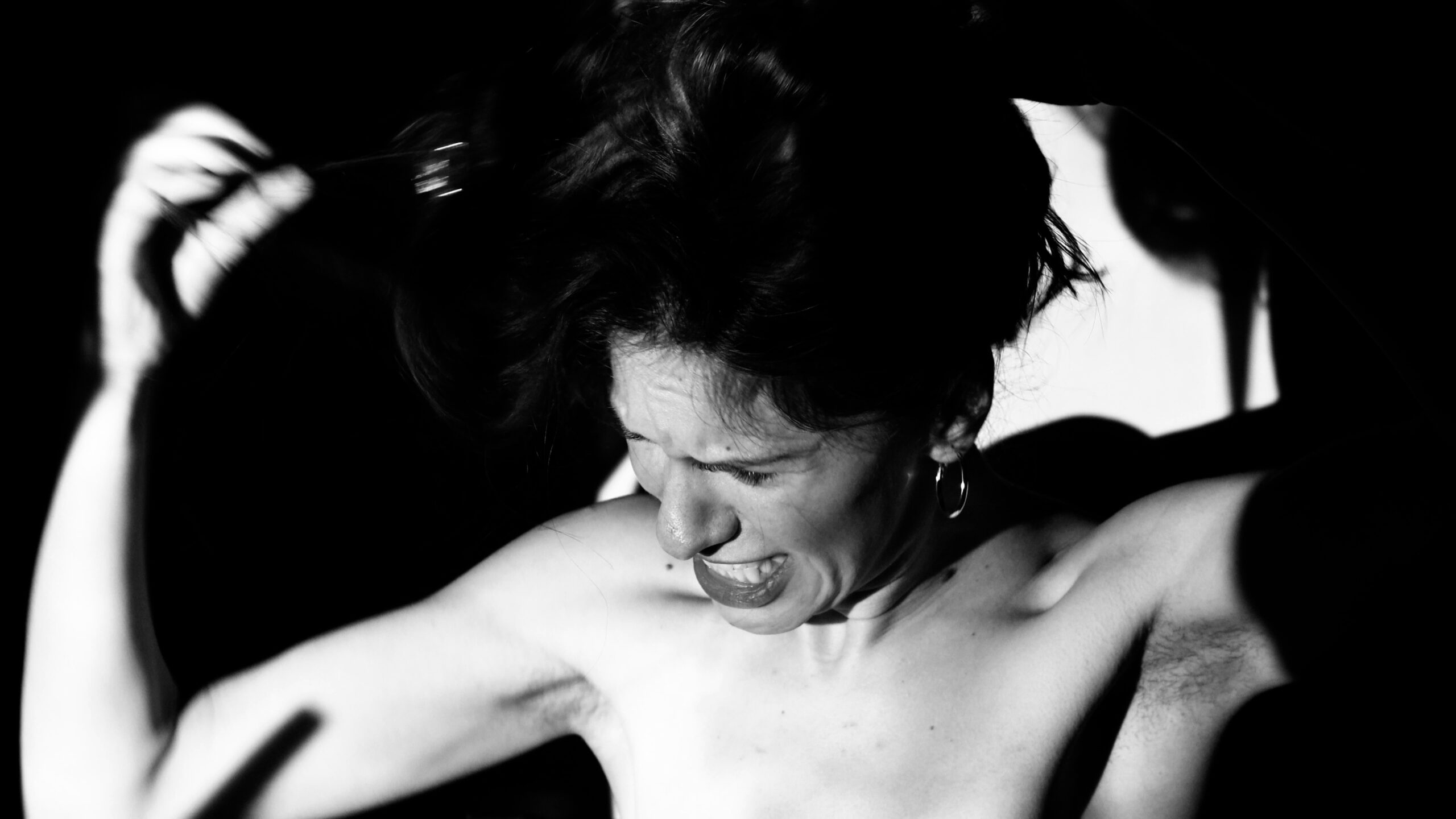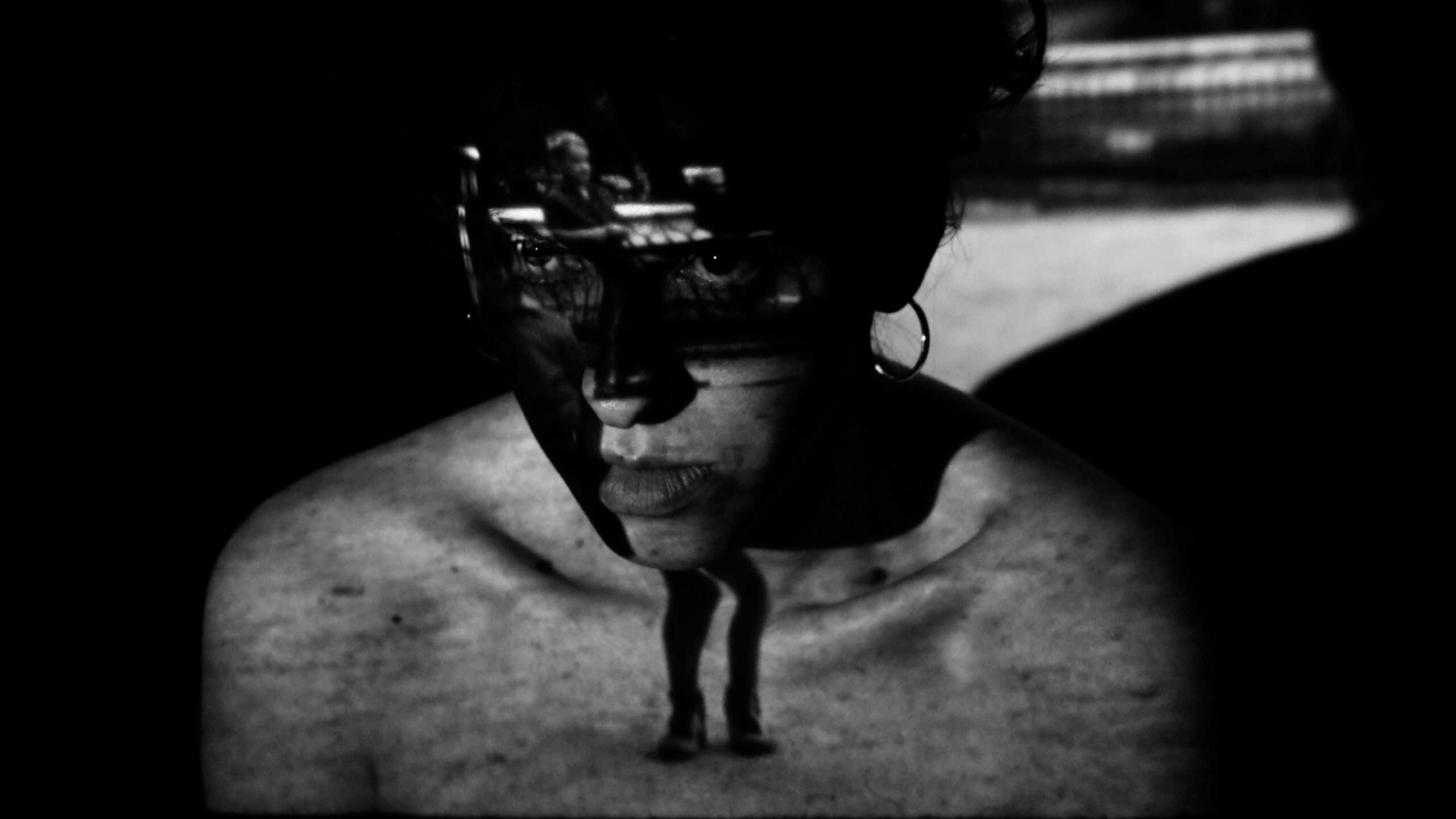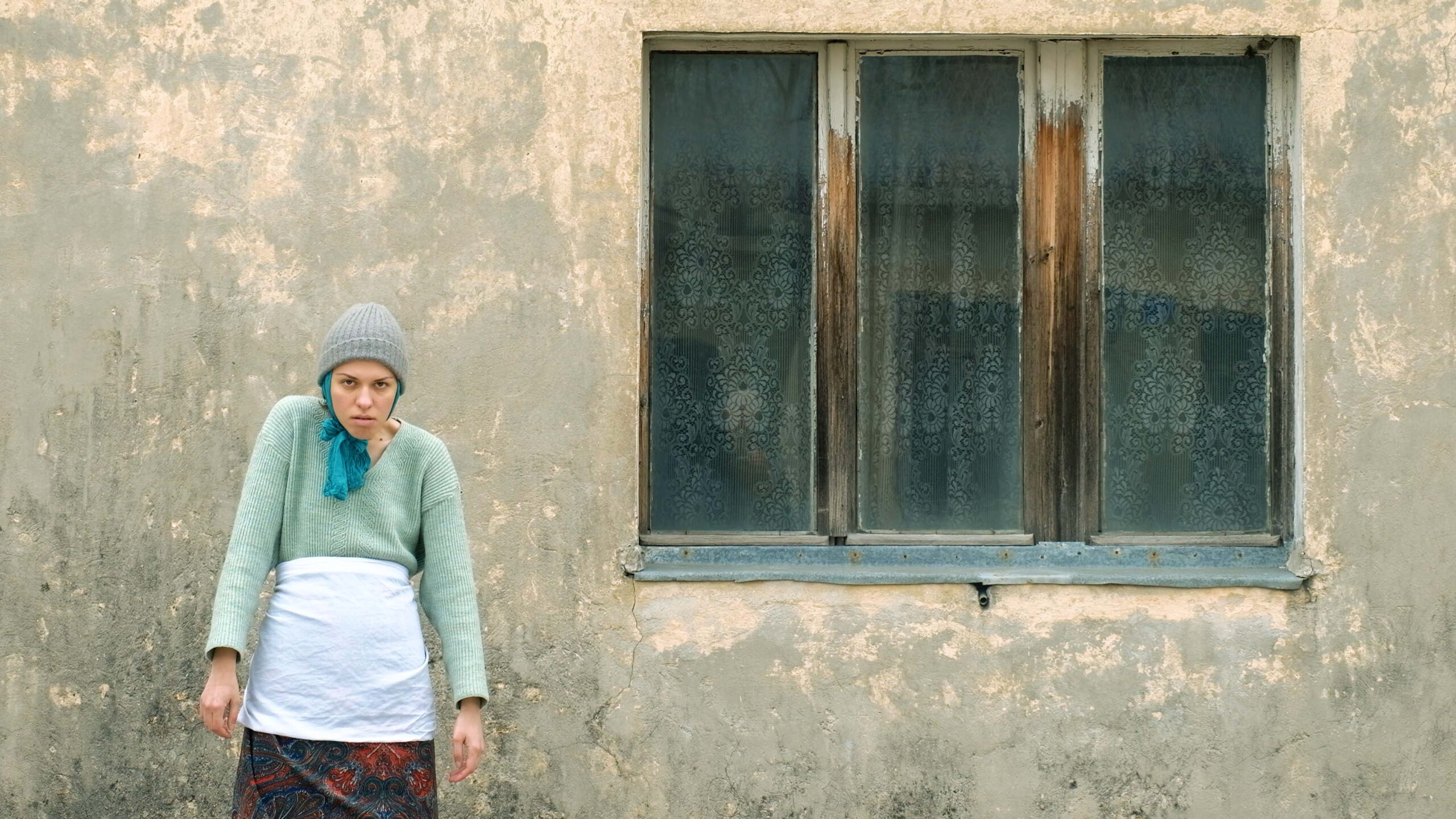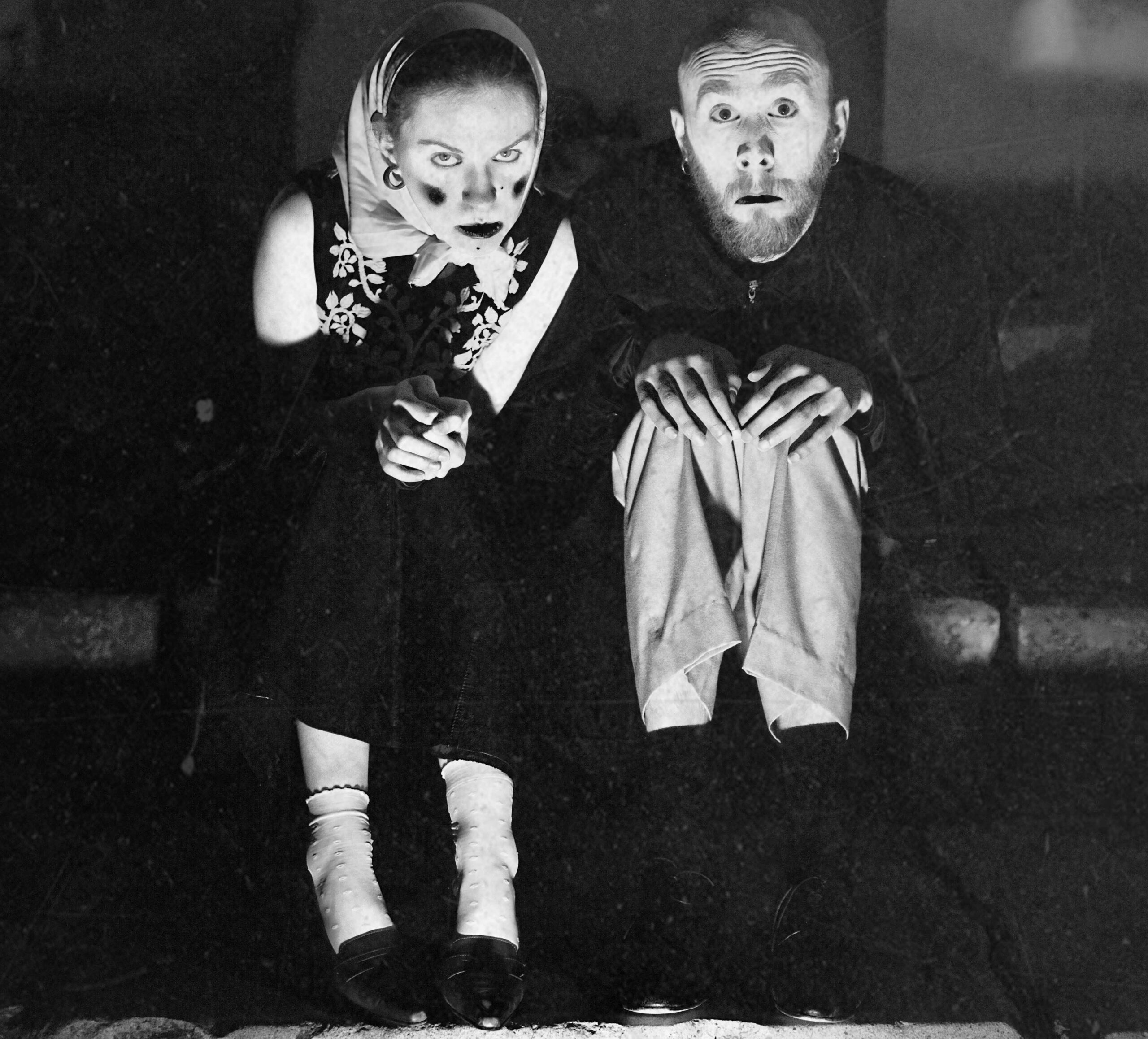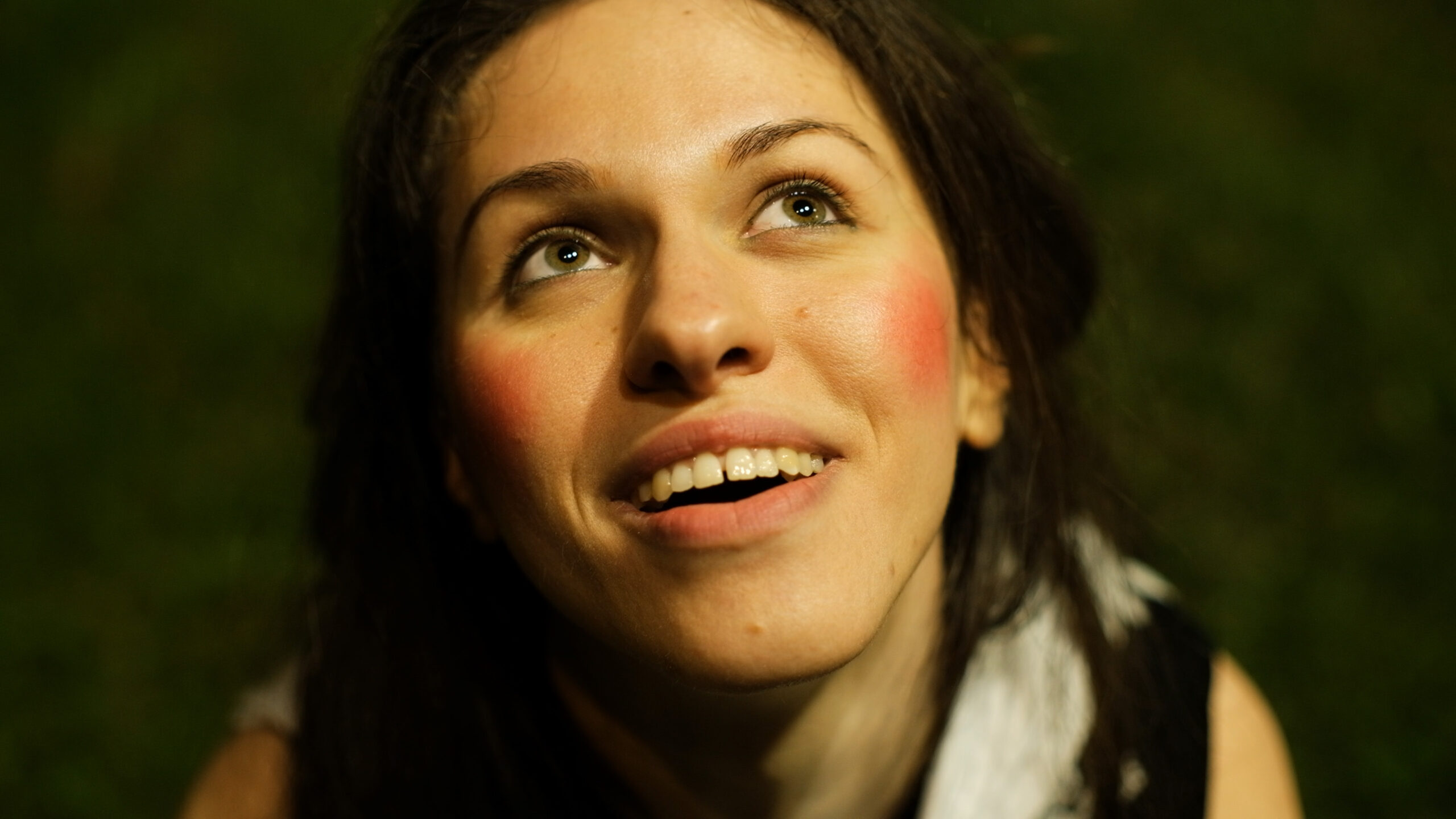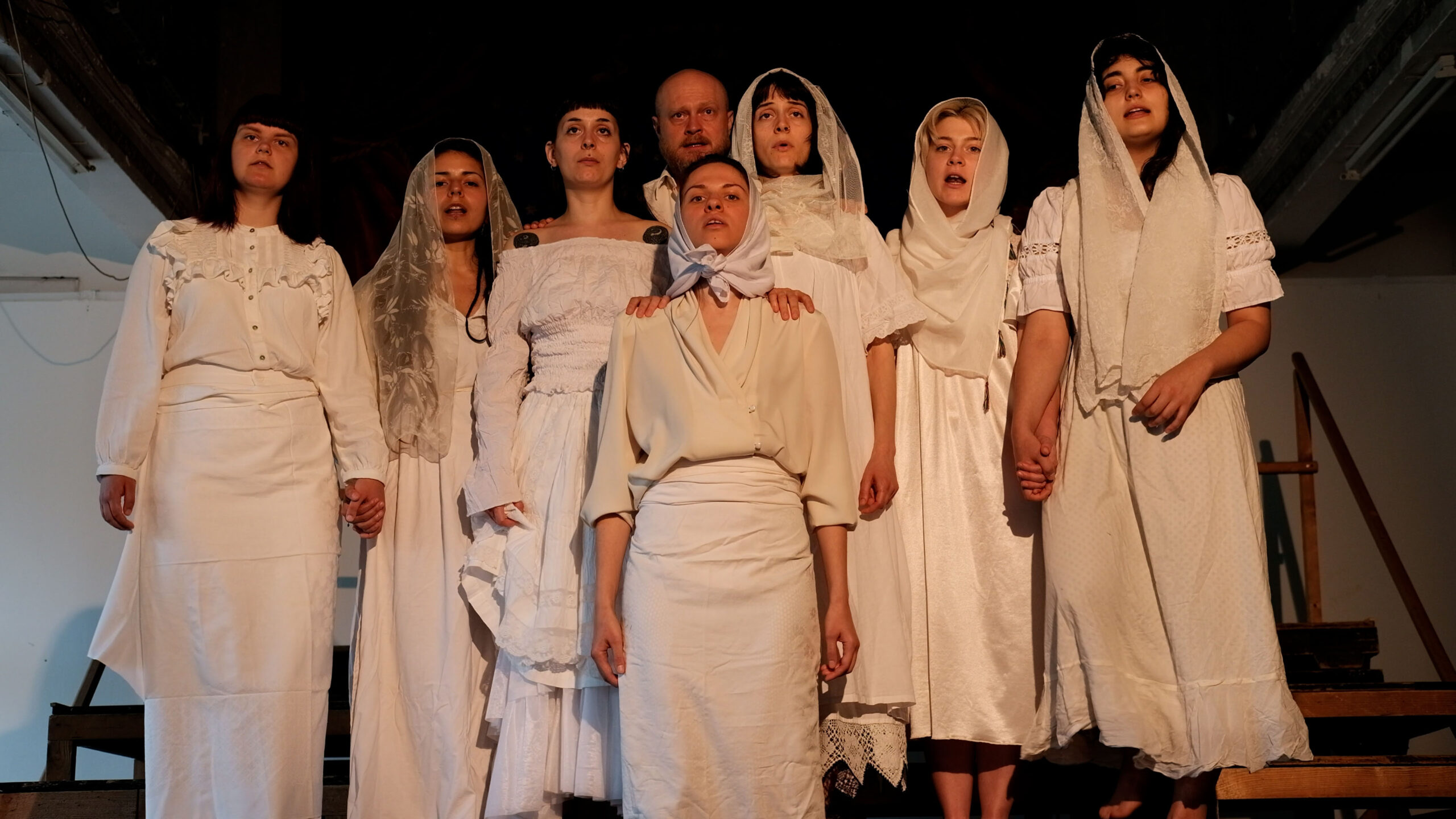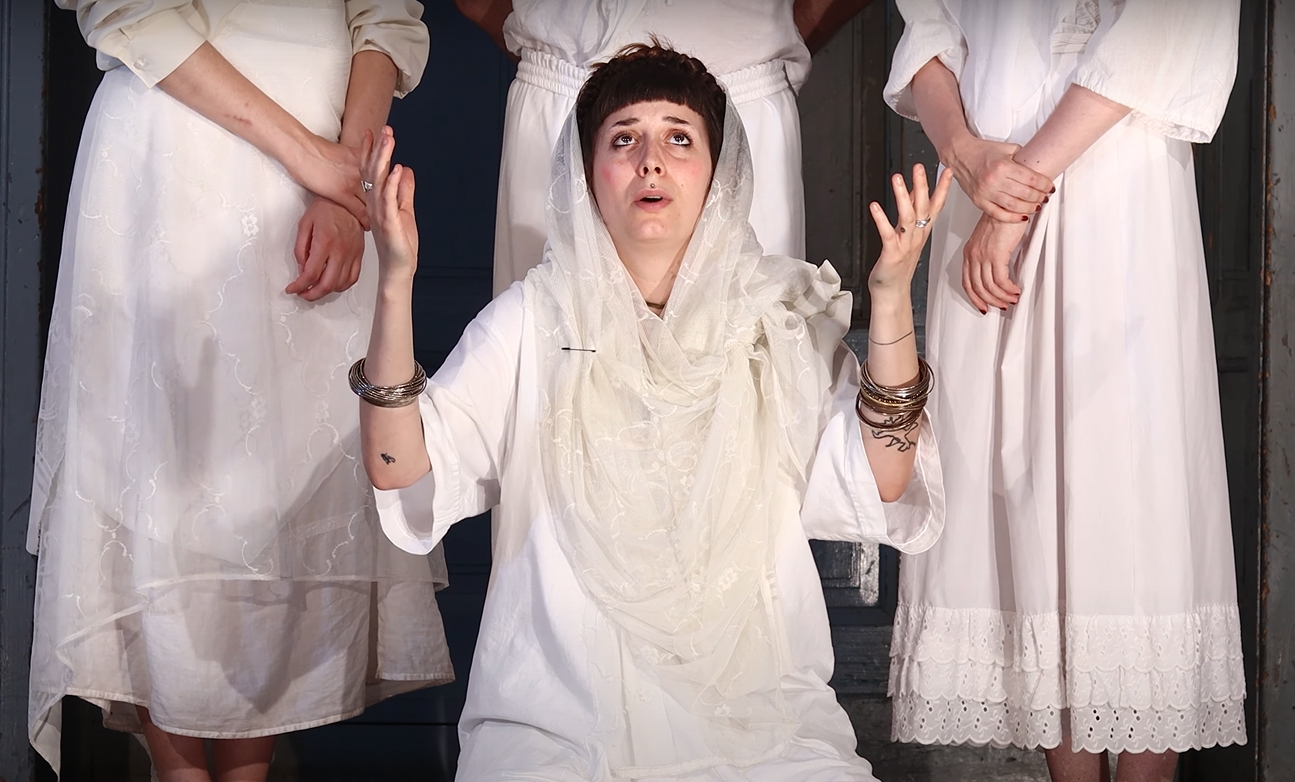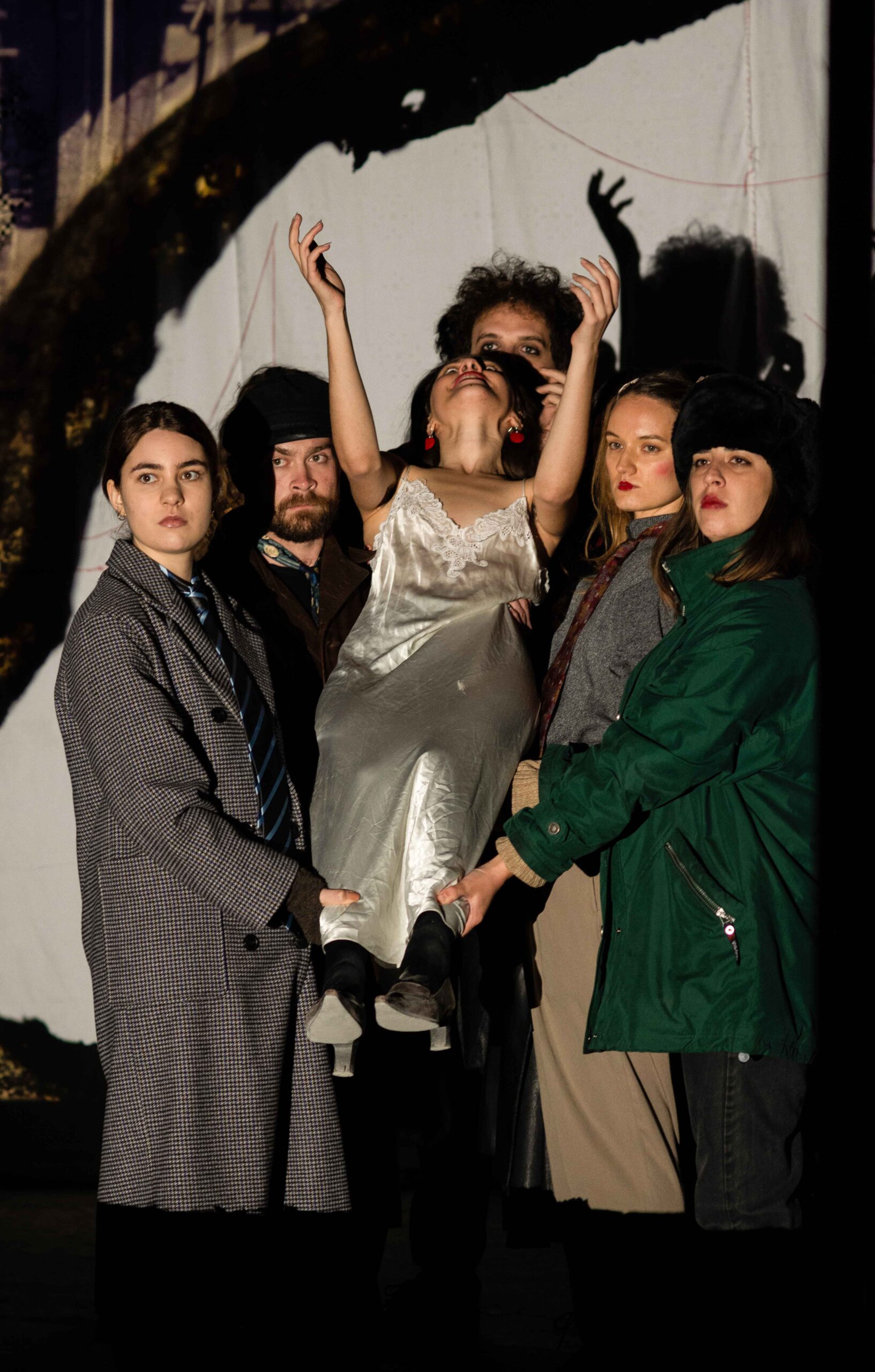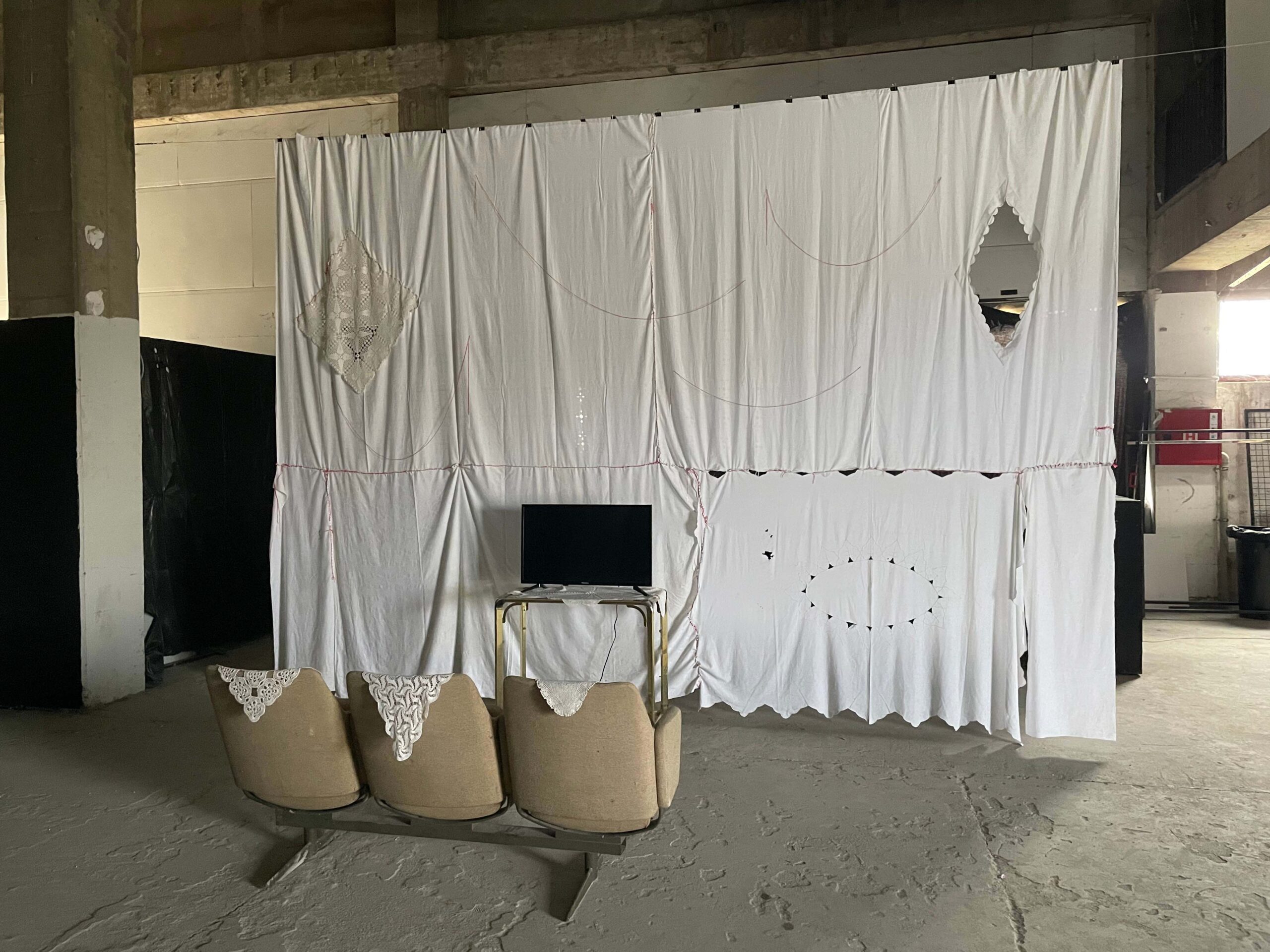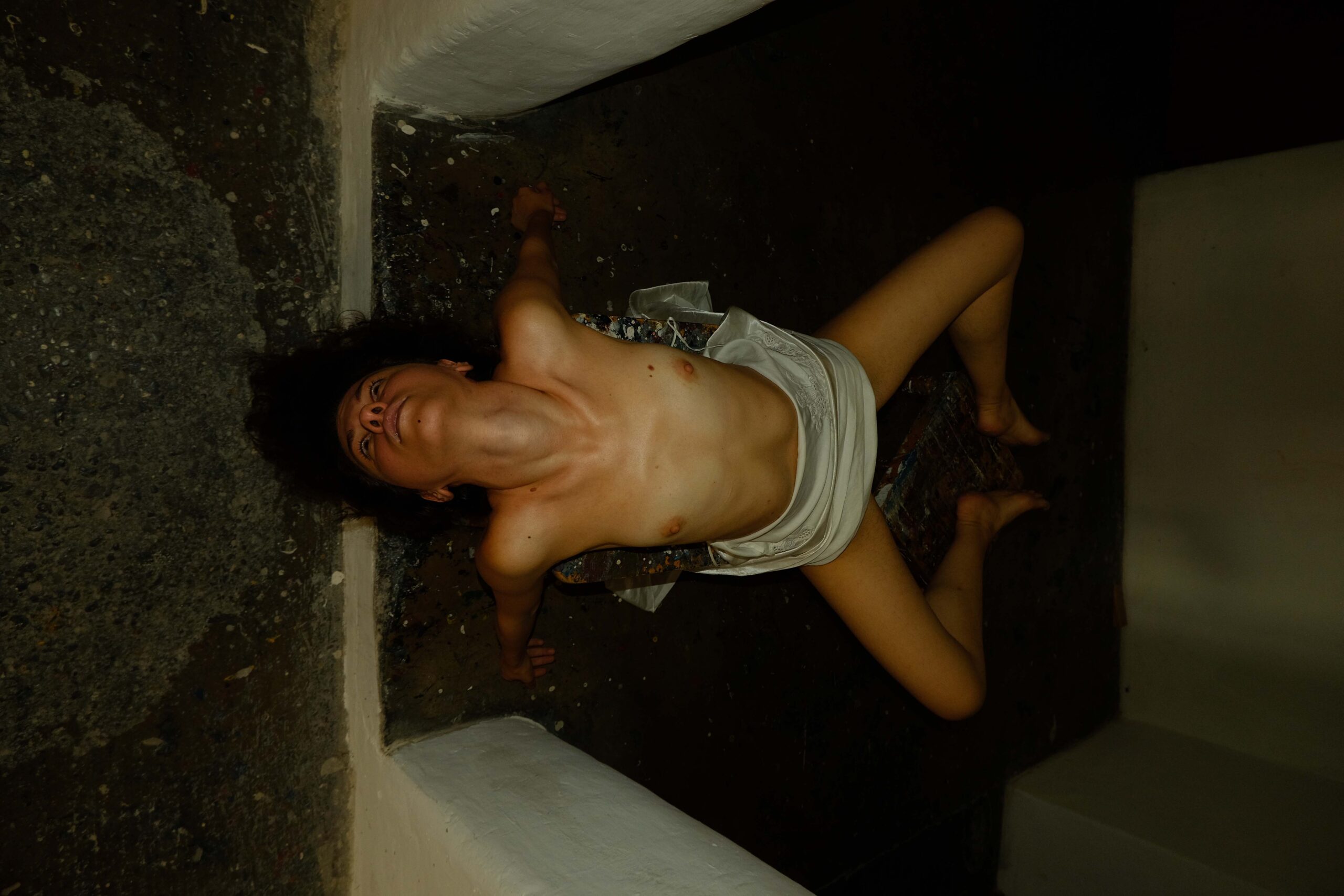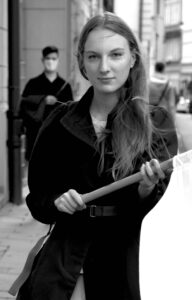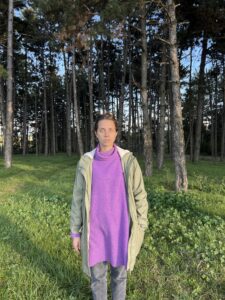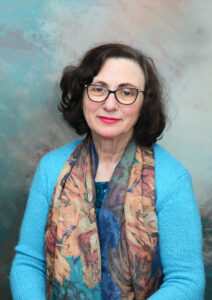Azra Omk
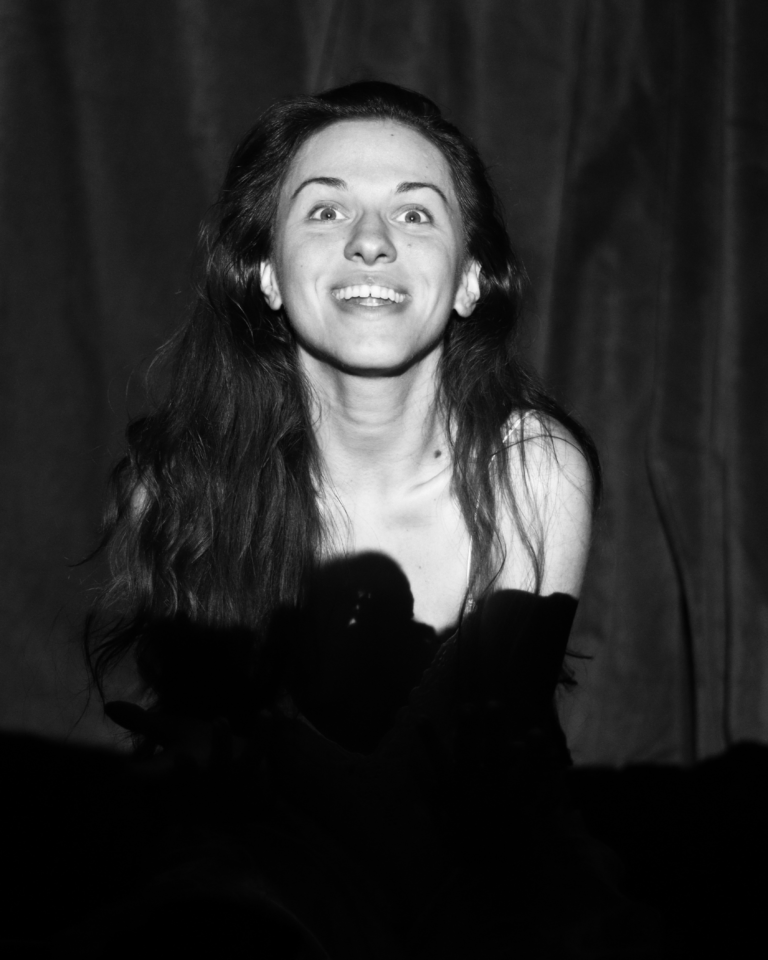
- 90s
- absurdity
- activism
- anti-capitalism
- anti-war
- archive
- artivism
- awareness
- body
- childhood
- collective memory
- collective practice
- communities
- critical art
- cultural memory
- duo
- identity politics
- national identity
- nationalism
- performance
- political systems
- politics of memory
- post-conflict
- remembrance
- resistance
- self-education
- storytelling
- subcultures
- theatre
- tools of oppression
- video performance
— born in 1998 in Bijelo Polje. She is an interdisciplinary artist who transitioned from painting to politically engaged, participatory art focused on collectives. She is in her final year of a master’s degree in Intermedia Arts at FLU Cetinje and has studied in Lisbon (2021) and Cluj-Napoca (2024) through the Erasmus+ program. Her performances fuse theater and contemporary art through body and voice, exploring social narratives and memory politics that shape contemporary society, drawing on personal and family experiences from the 1990s conflicts. She has participated in the IPAF Festival (Cetinje 2023, Turin 2024), the Body of Work II residency (BJCEM, Cyprus 2023), was a finalist in the 2024 Milčik program, a grant recipient of the 2024 Summer School in Salzburg, and a participant in the masterclass Cultivating Connections at Stacion – Center for Contemporary Art in Prishtina (2024), led by Dr. Ana Dević. She actively collaborates in an artistic duo with Vuko Peković, where they transform hegemonic narratives into artistic expressions through collective work. Their projects create spaces for critical dialogue and experimental artistic communities, exploring political constructs, social norms, and participatory formats in art.
Reflecting on my own journey, I increasingly realize how much my upbringing has shaped my artistic expression and practice. I grew up in the post-war years, between two countries, with a mother who was a refugee from Bosnia and a Montenegrin father (a Muslim). My identity and work have been shaped by this fragmented experience—not just between parents, but between the environments and narratives that defined them. A childhood spent between Brčko and Bijelo Polje, between learning El-Fatiha with my great-grandmother and singing church hymns in the school choir, between conflicting versions of history, shaped my need to explore stories that have been pushed to the margins through art. The stories of my family—of losing their home, my aunt surviving a concentration camp, or returning to a house that had been occupied—remain untold fragments of history that have guided my artistic inquiry toward a broader examination of the relationship between mnemo-history and historiography, language, ideology, and social norms. While academic circles often expect us to align with the Western canon, ignoring the complexities that define our region, my work through performance aims to create a space for dialogue and critical reflection.
Formal education in Montenegro remains hermetic, rigid, and disconnected from contemporary artistic discourse. It is trapped within outdated academic structures that offer little room for experimentation, interdisciplinary inquiry, or new artistic methodologies. Artistic expressions that challenge traditional formats are often perceived as a threat to established frameworks, leading to a form of segregation within the educational system itself. Performative practices, in particular, struggle to gain institutional recognition and are often dismissed as illegitimate art forms, relegated to the periphery. This rigid system not only stifles artistic experimentation but also prevents students from developing research that transcends conventional disciplinary boundaries. In response to these limitations, I naturally turned to alternative models of education and collaboration, engaging in informal networks, residency programs, international exchanges, and collective initiatives. These experiences have provided me with the freedom to experiment and develop contemporary artistic practices beyond the constraints of rigid institutional frameworks.
My artistic research began with an exploration of the body as a medium, focusing on communication that extends beyond verbal language. Body, voice, movement, and audience interaction became my primary artistic tools. A key influence on my development has been my partnership with Vuk Peković, whose background in theater directing and deep engagement with the stage shaped his artistic voice. While Vuk’s passion for theater and directorial studies informed his creative approach, my own research into the body was shaped by Jan Fabre’s exercises, Boal’s Theater of the Oppressed, and his followers. Together we began incorporating techniques from Pina Bausch, Grotowski, Rancière, Butler, and Schechner, seeking to challenge established artistic hierarchies. The need to build art not only as an individual expression but as a collective act is something that drives me toward collaborative work. The moment when another person’s success and growth becomes as significant as my own, I begin to understand that art does not happen in isolation. It is shaped through interaction, exchange, and shared creation. This is what I aim to expand beyond just the two of us, bringing it into collectives and communities who believe in the same process.
Vuk and I initiated our collaborative artistic practice upon realizing how deeply we had been conditioned through both the education system and societal norms to perceive art as an elevated and autonomous entity, disconnected from real-life struggles and political realities. This perspective creates the illusion of artistic autonomy, while in reality, art is inseparable from the socio-political and cultural contexts in which it exists. Our work is driven by the need to bridge this artificial gap, merging artistic expression with daily realities, political discourse, and lived experience. We are particularly focused on translating social and political phenomena into sensory experiences and exploring how art can become a space for critical thought and response.
Beyond performance itself, our work encompasses scenography, costume design, filming and sound, photography, editing, and artistic direction, all while maintaining a pedagogical approach when working with people. One of the first video performances, Sjeme ti se zatrlo12, is the result of research on curses and language, specifically its genocidal dimension and normalization within our society.
The first work in which we were both present in front of the camera was Little City Cetinje3, a satirical and comedic portrayal of Cetinje, a city whose cultural and historical significance has been overshadowed by ultranationalist movements and a local reality reduced to three key points of social life – the tavern, the chapel, and the betting shop. This work was created as part of a university assignment and served as our satirical response to the Shadow Cities project, yet another in a series of insidious and superficial attempts to present Cetinje and Krakow as cities with similar destinies.
In reality, projects like these ignore the complexity of local contexts and reduce them to simplified narratives tailored to institutional expectations. Little City Cetinje combined elements of clowning, video performance, documentary, and docu-fiction, critically examining failed cultural initiatives, including the unrealized research center of Marina Abramović, as well as the way the local community perceives these changes.
The next collaborative work, The Game of Circumstances45, was created during an Erasmus+ exchange in Romania, born out of frustration with one of the many scandals on Montenegro’s cultural scene. The artistic director of the Nikšić theater refused to stage a feminist play, claiming that feminism was an “exhausted idea” and that, in reality, women were the ones discriminating against men. This act of misogyny and institutional suppression of critical narratives inspired us to respond directly through subversive affirmation. We used his email verbatim, word for word. The performance was filmed on the street, relying solely on street lighting, as we had no access to resources, but the urgency to react was stronger than the limitations.
During our time in Romania, we encountered a much greater openness to artistic collaboration and idea-sharing, as well as functional alternative spaces that support experimental practices. Within this environment, Jad Božii I7 and Jad Božii II8 were conceived. Both projects use subversive affirmation as a method to examine and expose the normalization of hate speech. Jad Božii I focuses on the rhetoric of religious circles and their role in spreading ideologized intolerance, while Jad Božii II investigates the use of extremist language among young people, particularly within football fan groups.
These projects were carried out in collaboration with ten participants from five different countries, many of whom had little or no previous experience in performance or singing. The musical preparation was led by young conductor Hana Budrala, while Vuk and I conducted workshops on physical exercises, movement, and relaxation techniques for performing on camera and during live performances. The project was realized with the support of the Anarchist House and the Transit House, a space that has undergone a historical transformation from a factory to a synagogue and finally into a contemporary cultural center, providing an inspiring context for research and performance.
The Milčik Mentorship Program, which concluded with an exhibition where I was a finalist, provided me with an opportunity for artistic presentation. Instead of focusing solely on individual work, I chose to organize a collective performance, which led to the founding of the first local collective under the name Sredljud (Middleman).
Although Montenegro is our home country, the process of forming a collective has proven to be significantly more challenging than in Romania. Institutional support for young artists is almost nonexistent, the university did not recognize the initiative, and there are very few alternative spaces for artistic work. Despite these challenges, we managed to bring together a group of eight people with whom we developed a collective artistic expression through intensive performative and somatic exercises.
The final outcome of this process was the performance ” Mir, mir, mir, niko nije kriv”910, which took shape as a performative installation with a production process lasting several months. The performance combined elements of clowning, lecture performance, choral singing, and intimate documentary, exploring the absurdity, sorrow, and weight of the past thirty years in the former Yugoslav states. Whether consciously or unconsciously, we all carry the consequences of that war, and this work was our attempt to articulate them through collective artistic research.
Despite everything, I do not make a living from the art I create and love. In order to sustain my projects, I am forced to work in commercial fields such as videography, photography, and design, pursuits that are far removed from what truly interests me. I have no other choice, as artistic work in Montenegro rarely provides financial stability, and performance as a medium is nearly absent from institutional frameworks. Every day is a balancing act between work that pays the bills and work that exhausts me but has meaning. Working in commercial fields means dealing with people, their expectations, and demands, while preparing and executing a performance requires an entirely different level of energy and presence. This means constantly shifting between two worlds, between working out of necessity and creating out of inner compulsion.
At the same time, while we engage with local issues and politics, we strive to clearly separate our work on these topics from the Western gaze, a perspective that often views the Balkans as an undefined space between the East and the West. This liminal position is frequently exploited to construct narratives that place us in an unbearable in-between state, neither poor enough to evoke pity and justify endless peacekeeping missions nor good enough to stand among the stars. We aim to expose and redirect such discourse. Our work is based on the deconstruction of dominant narratives and critical reexamination of collective memory, creating space for new interpretations of both the past and the present. Through performance, art, and subversive affirmation, we seek to translate the political into the sensory, challenge entrenched perceptions, and open space for a more nuanced understanding of history and contemporary reality.
1Image: [Śjeme ti se zatrlo], 2023, video performance, in collaboration with Vuk Peković. Courtesy of the artists
2Image: [Śjeme ti se zatrlo], 2023, video performance, in collaboration with Vuk Peković. Courtesy of the artists.
3Image: Little City Cetinje, 2023, video installation. Courtesy of the artist.
4Image: Azra and Vuk Peković shooting The Game of Circumstances, 2024, video performance. Courtesy of the artists.
5Image: The Game of Circumstances, 2024, video performance, in collaboration with Vuk Peković. Courtesy of the artists.
6Image: Mother Always Cursed Us, live performance, 2024, Salzburg Summer Academy. Courtesy of the artist.
7Image: Jad Božii I, 2024, video performance at Transit House, Romania, in collaboration with Vuk Peković, Hanna Budrala, Marco Pilero, Musca, Andrada Jichici, Roxana Csucsak, Marco Pilerio, Larisa Stan, Demetra Vasiliu, Gyöngyvér Kun. Courtesy of the artists.
8Image: Jad Božii II, 2024, video performance, in collaboration with Vuk Peković, Marco Pilero, Musca, and Gyöngyvér Kun, at Transit House, Romania. Courtesy of the artists.
9Image: No One Is Guilty [Mir, mir, mir, niko nije kriv], 2024, installation, Milčik finalist exhibition, in collaboration with Vuk Peković and Sredljud collective. Courtesy of the artists and Jovan Milošević.
10Image: No One Is Guilty [Mir, mir, mir, niko nije kriv], 2024, installation, Milčik finalist exhibition, in collaboration with Vuk Peković and Sredljud collective. Courtesy of the artists and Jovan Milošević.
— rođena 1998. u Bijelom Polju. Interdisciplinarna je umjetnica koja se od slikarstva usmjerila ka politički angažovanoj i participativnoj umjetnosti sa fokusom na kolektive. Na završnoj je godini master studija Intermedijalnih umjetnosti na FLU Cetinje, a kroz Erasmus+ program studirala je u Lisabonu (2021) i Cluj-Napoci (2024). Njeni performansi spajaju teatar i savremenu umjetnost kroz tijelo i glas, istražujući društvene narative i memorijske politike koje oblikuju savremeno društvo, oslanjajući se na lična i porodična iskustva iz konflikata 90-ih.. Učestvovala je na IPAF festivalu (Cetinje 2023, Torino 2024), rezidenciji Body of Work II (BJCEM, Kipar 2023), bila je finalistkinja Milčik programa 2024., stipendistkinja ljetnje škole u Salzburgu 2024., kao i učesnica master class-a ‘Cultivating Connections’ u Stacion, Centru za savremenu umjetnost u Prištini (2024), koji je vodila dr Ana Dević. Aktivna je u umjetničkom duu sa Vukom Pekovićem, gdje kroz kolektivni rad transformišu hegemonijske narative u umjetničke izraze. Njihovi projekti stvaraju prostore za kritički dijalog i eksperimentalne umjetničke zajednice, kroz koje istražuju političke konstrukcije, društvene norme i participativne formate u umjetnosti.
Razmišljajući o sopstvenom putu, sve više shvatam koliko je moje odrastanje oblikovalo moj trenutni umjetnički izraz i okupaciju. Odrasla sam u postratnim godinama između dvije države, s majkom koja je bila izbjeglica iz Bosne i ocem Crnogorcem (muslimanom). Moj identitet i rad oblikovani su upravo tim razapetim iskustvom, ne samo između roditelja, već između sredina i narativa koji su ih oblikovali. Djetinjstvo provedeno između Brčkog i Bijelog Polja, između učenja El-Fatihe sa prabakom i pjevanja crkvenih pjesama u školskom horu, između različitih verzija prošlosti oblikovalo je moju potrebu da kroz umjetnost istražujem priče koje su gurnute na marginu. Priče o mojoj porodici, o gubitku doma, o mojoj tetki koja je preživjela koncentracioni logor, ili o povratku u dom koji bio okupiran, ostaju neispričani fragmenti istorije koji su usmjerili moj umjetnički rad ka širem ispitivanju odnosa između mnemoistorije i istoriografije, jezika, ideologije i društvenih normi. Dok se u akademskim krugovima od nas očekuje da se oslonimo na zapadni kanon, često zanemarujući kompleksne narative koji definišu naš region, ja pokušavam da kroz performans otvorim prostor za dijalog.
Formalno obrazovanje u Crnoj Gori je hermetično, zatvoreno u zastarjele akademske strukture koje ne nude prostor za istraživanje i multidisciplinarni pristup. Umjetnički izrazi koji izlaze izvan tradicionalnih formi doživljavaju se kao prijetnja ustaljenim okvirima, što dovodi do segregacije unutar samog obrazovnog sistema. Posebno je izražena marginalizacija performativnih praksi, koje se često ne prepoznaju kao legitimne umjetničke forme, već ostaju na periferiji institucionalnog priznanja. Ovakav sistem ne samo da sputava eksperimentisanje i razvoj novih umjetničkih jezika, već i onemogućava studentima da pronađu podršku za istraživački rad koji nadilazi granice pojedinačnih disciplina. U takvom okruženju prirodno sam se okrenula alternativnim modelima obrazovanja i saradnje kroz neformalne mreže, rezidencijalne programe, međunarodne razmjene i kolektivne inicijative koje mi omogućavaju slobodu eksperimentisanja i razvoj savremenih umjetničkih praksi van rigidnih institucionalnih okvira.
Moje istraživanje u umjetnosti počelo je kroz istraživanje tijela kao medija i komunikacije koja prevazilazi verbalno. Tijelo, glas, pokret i interakcija sa publikom postali su moj primarni jezik. Ključan uticaj na moj razvoj imao je rad sa partnerom i saradnikom Vukom Pekovićem. Zajednički život nas je doveo do zajedničkog stvaralaštva. Vukova zaljubljenost u teatar kao i studiranje pozorišne režije je oblikovalo njegov izraz dok je moj zanimanje za tijelo kroz Jan Fabreove vježbe i istraživanje potlačenosti tijela kod Boala i njegovih sljedbenika, zajedno smo krenuli u primjenjivanje tehnika Pine Bauch, Grotovskog, istrazivanje Ransijera, Butlerove, Schehnera..Potreba da se umjetnost ne gradi samo na individualnom izrazu, već kroz zajedništvo i podršku, nešto je što me gura u zajednički rad. Osjećaj kada uspjeh i napredak druge osobe doživljen kao sopstveni, kroz koji razumijem da se umjetnost ne dešava u vakuumu već kroz interakciju, dijeljenje i međusobno oblikovanje, ono je što želim širiti dalje, izvan nas dvoje, u kolektive, u ljude koji vjeruju u isti proces. Moj rad često se bavi problemima nacionalizma, fašizma i mitomanije kroz performans i eksperimentalni dokumentarizam.
Vukovo i moje zajedničko umjetničko djelovanje započelo je kada smo prepoznali kako smo kroz obrazovni sistem i društvene norme naučeni da umjetnost posmatramo kao izdvojenu, uzvišenu sferu, odvojenu od stvarnog života i društvenih problema. Ovakav pristup stvara iluziju umjetnosti kao autonomnog entiteta, dok smo mi kroz svoj rad nastojali da premostimo tu distancu i povežemo naš umjetnički izraz sa svakodnevnim iskustvima, političkim i društvenim kontekstima. Fokus nam je postao prevođenje društvenih i političkih fenomena u čulno, istražujući kako umjetnost može postati prostor za kritičko promišljanje i reakciju.
Naši radovi, pored same izvedbe, obuhvataju scenografiju i kostimografiju, snimanje i fotografisanje, montažu i dizajn, kao i pedagoški pristup u radu s drugim ljudima. Jedan od prvih video performansa Sjeme ti se zatrlo12, rezultat je istraživanja kletvi i jezika odnosno njegove genocidne dimenzije i normalizaciju unutar našeg društva.
Prvi rad u kojem smo oboje prisutni pred kamerom bio je Little City Cetinje3, satirični i komični prikaz Cetinja, grada čija je kulturno-istorijska vrijednost danas zasjenjena ultranacionalističkim pokretima i lokalnom realnošću svedenom na tri ključne tačke društvenog života – kafanu, kapelu i kladionicu. Ovaj rad nastao je kao dio zadatka na fakultetu i predstavljao je naš satirični odgovor na projekat Shadow Cities, još jedan u nizu perfidnih i površnih pokušaja da se Cetinje i Krakov predstave kao gradovi sa sličnom sudbinom. U stvarnosti, ovakvi projekti ignorišu složenost lokalnih konteksta i svode ih na pojednostavljene narative prilagođene institucionalnim očekivanjima. Rad Little City Cetinje spojio je elemente clowninga, video performansa, dokumentarca i doku-fikcije, istražujući propale kulturne inicijative, uključujući i neostvareni istraživački centar Marine Abramović, te način na koji lokalna zajednica percipira ove promjene.
Sljedeći zajednički rad, Igra slučaja45 nastao je tokom Erasmus+ razmjene u Rumuniji, iz frustracije izazvane jednim od skandala na crnogorskoj kulturnoj sceni. Umjetnički direktor pozorišta u Nikšiću odbio je izvođenje feminističke predstave, uz obrazloženje da je feminizam „istrošena ideja” i da zapravo žene diskriminišu muškarce. Ovaj čin mizoginije i institucionalnog gušenja kritičkih narativa inspirisao nas je da kroz subverzivnu afirmaciju direktno odgovorimo na taj postupak. Koristeći njegov e-mail doslovno, riječ po riječ. Performans je snimljen na ulici, oslanjajući se na ulično osvjetljenje, jer nismo imali pristup resursima, ali je želja za reakcijom bila jača.
Tokom boravka u Rumuniji susreli smo se s mnogo većom otvorenošću za umjetničku saradnju i dijeljenje ideja, kao i sa funkcionalnim alternativnim prostorima koji podržavaju eksperimentalne prakse. U tom okruženju nastali su Jad Božii I7 i Jad Božii II8. Oba projekta oslanjaju se na subverzivnu afirmaciju kao metod za istraživanje i razotkrivanje normalizacije govora mržnje. Jad Božii I fokusiran je na retoriku vjerskih krugova i njihovu ulogu u širenju ideologizovane netrpeljivosti, dok Jad Božii II istražuje upotrebu ekstremističkog jezika među mladima, posebno u navijačkim grupama. Ovi projekti realizovani su u saradnji sa deset učesnika iz pet različitih zemalja, od kojih su mnogi imali malo ili nikakvo prethodno iskustvo u nastupu i pjevanju. Ključnu ulogu u muzičkoj pripremi imala je mlada dirigentkinja Hana Budrala, dok smo Vuk i ja vodili radionice tjelesnih vježbi, pokreta i tehnika opuštanja pred kamerom i tokom javnog nastupa. Projekat je realizovan uz podršku Anarhističke kuće i Tranzit kuće, prostora koji je kroz svoju istoriju prošao transformaciju od fabrike, preko sinagoge, do savremenog kulturnog centra, pružajući tako inspirativan kontekst za istraživanje i izvedbu.
Milčik mentorski program, koji je završen izložbom u kojoj sam bila finalistkinja, pružio mi je priliku za umjetničko predstavljanje. Umjesto da se fokusiram isključivo na individualni rad, odlučila sam da organizujem kolektivni performans, što je rezultiralo osnivanjem prvog lokalnog kolektiva pod nazivom Sredljud (Middleman).
Iako je Crna Gora naša matična zemlja, proces formiranja kolektiva pokazao se znatno izazovnijim nego u Rumuniji. Institucionalna podrška mladim umjetnicima gotovo da ne postoji, fakultet nije prepoznao inicijativu, a alternativnih prostora za rad ima veoma malo. Uprkos tim poteškoćama, uspjeli smo okupiti grupu od osam ljudi s kojima smo kroz intenzivne performativne i somatske vježbe razvili kolektivni izraz. Krajnji rezultat ovog procesa bio je performans “Mir, mir, mir, niko nije kriv”910, koji se oblikovao kao performativna instalacija čija je produkcija trajala nekoliko mjeseci. Performans je kombinovao elemente clowninga, lecture performansa, horskog izvođenja i intimnog dokumentarizma, istražujući apsurd, tugu i težinu nasljeđa posljednjih trideset godina u državama bivše Jugoslavije. Svi mi, svjesno ili nesvjesno, nosimo posljedice tog rata, a ovaj rad bio je naš pokušaj da ih artikulišemo kroz kolektivno umjetničko istraživanje.
Uprkos svemu, ja ne živim od umjetnosti koju stvaram i volim. Da bih mogla da radim na svojim projektima, primorana sam da se bavim komercijalnim poslom odnosno videografijom, fotografijom i dizajnom u svrhe koje su daleko od onoga što me suštinski zanima. Nemam izbora, jer u Crnoj Gori umjetnički rad rijetko donosi ikakvu finansijsku stabilnost, a performans kao medij gotovo da ne postoji u institucionalnim okvirima. Svaki dan je balansiranje između rada koji plaća račune i rada koji iscrpljuje, ali ima smisla. Raditi u komercijalnim okvirima znači baviti se ljudima, njihovim očekivanjima i zahtjevima, dok rad na pripremi i realizaciji performansa zahtijeva potpuno drugačiji nivo energije i prisustva. To znači neprestano kretanje između dva svijeta, između rada iz nužde i stvaranja iz potrebe.
Istovremeno, dok se bavimo lokalnim temama i politikom, nastojimo jasno odvojiti svoj rad na tim pitanjima od zapadnog pogleda – perspektive koja Balkan često vidi kao neodređeni prostor između Istoka(Juga) i Zapada. Ova granična pozicija često se koristi za oblikovanje narativa koji nas smještaju u nepodnošljivu međupoziciju – ni dovoljno siromašne, tj. „prirodno bogate“, da bismo izazvali sažaljenje i beskrajne mirovne misije, ni dovoljno „dobre“ da bismo stajali rame uz rame sa zvijezdama. Nastojimo razotkriti i preusmjeriti takav diskurs. Naš rad se zasniva na dekonstrukciji dominantnih narativa i kritičkom preispitivanju kolektivnog sjećanja, otvarajući prostor za nove interpretacije prošlosti i sadašnjosti. Kroz performans, umjetnost i subverzivnu afirmaciju, nastojimo prevesti političko u čulno, izazvati ukorijenjene percepcije i stvoriti prostor za složeniji pogled na istoriju i savremenu stvarnost.
1
Foto: Śjeme ti se zatrlo, 2023, video performans, u saradnji sa Vukom Pekovićem. Ustupljeno ljubaznošću umjetnika.
2
Foto: Śjeme ti se zatrlo, 2023, video performans, u saradnji sa Vukom Pekovićem. Ustupljeno ljubaznošću umjetnika.
3
Foto: Little City Cetinje, 2023, video instalacija. Ustupljeno ljubaznošću umjetnice.
4
Foto: Azra i Vuk Peković na snimanju Igre Slučaja, 2024, video performans. Ustupljeno ljubaznošću umjetnika.
5
Foto: Igra Slučaja, 2024, video performans, u saradnji sa Vukom Pekovićem. Ustupljeno ljubaznošću umjetnika.
6
Foto: Majka nas je vazda klela, performans uživo, 2024, Salzburška ljetnja akademija. Ustupljeno ljubaznošću umjetnice.
7
Foto: Jad Božii I, 2024, video performans u Transit kući, Rumunija, u saradnji sa Vukom Pekovićem, Hannom Budralom, Marcom Pilerom, Muscom, Andradom Jichici, Roxanom Csucsak, Marcom Pileriom, Larisom Stan, Demetrom Vasiliu, Gyöngyvér Kun. Ustupljeno ljubaznošću umjetnika.
8
Foto: Jad Božii II, 2024, video performans, u saradnji sa Vukom Pekovićem, Marcom Pilerom, Muscom i Gyöngyvér Kun, u Transit kući, Rumunija. Ustupljeno ljubaznošću umjetnika.
9
Foto: Mir, mir, mir, niko nije kriv, 2024, instalacija, Milčik finalna izložba, u saradnji sa Vukom Pekovićem i kolektivom Sredljud. Ustupljeno ljubaznošću umjetnika i Jovana Miloševića.
10
Foto: Mir, mir, mir, niko nije kriv, 2024, instalacija, Milčik finalna izložba, u saradnji sa Vukom Pekovićem i kolektivom Sredljud. Ustupljeno ljubaznošću umjetnika i Jovana Miloševića.
- 90s
- absurdity
- activism
- anti-capitalism
- anti-war
- archive
- artivism
- awareness
- body
- childhood
- collective memory
- collective practice
- communities
- critical art
- cultural memory
- duo
- identity politics
- national identity
- nationalism
- performance
- political systems
- politics of memory
- post-conflict
- remembrance
- resistance
- self-education
- storytelling
- subcultures
- theatre
- tools of oppression
- video performance
